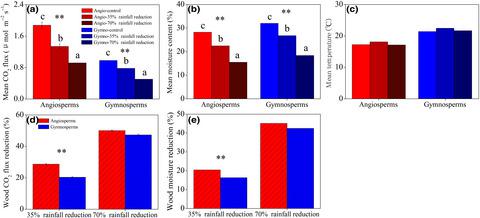当前位置:
X-MOL 学术
›
Glob. Change Biol.
›
论文详情
Our official English website, www.x-mol.net, welcomes your feedback! (Note: you will need to create a separate account there.)
Traits mediate drought effects on wood carbon fluxes.
Global Change Biology ( IF 11.6 ) Pub Date : 2020-04-13 , DOI: 10.1111/gcb.15088 Zhenhong Hu 1, 2, 3 , Han Y H Chen 4, 5 , Chao Yue 2 , Xiao Ying Gong 5 , Junjiong Shao 1 , Guiyao Zhou 1 , Jiawei Wang 1 , Minhuang Wang 6 , Jianyang Xia 1, 7 , Yongtao Li 3 , Xuhui Zhou 1, 8 , Sean T Michaletz 9
Global Change Biology ( IF 11.6 ) Pub Date : 2020-04-13 , DOI: 10.1111/gcb.15088 Zhenhong Hu 1, 2, 3 , Han Y H Chen 4, 5 , Chao Yue 2 , Xiao Ying Gong 5 , Junjiong Shao 1 , Guiyao Zhou 1 , Jiawei Wang 1 , Minhuang Wang 6 , Jianyang Xia 1, 7 , Yongtao Li 3 , Xuhui Zhou 1, 8 , Sean T Michaletz 9
Affiliation

|
CO2 fluxes from wood decomposition represent an important source of carbon from forest ecosystems to the atmosphere, which are determined by both wood traits and climate influencing the metabolic rates of decomposers. Previous studies have quantified the effects of moisture and temperature on wood decomposition, but these effects were not separated from the potential influence of wood traits. Indeed, it is not well understood how traits and climate interact to influence wood CO2 fluxes. Here, we examined the responses of CO2 fluxes from dead wood with different traits (angiosperm and gymnosperm) to 0%, 35%, and 70% rainfall reduction across seasonal temperature gradients. Our results showed that drought significantly decreased wood CO2 fluxes, but its effects varied with both taxonomical group and drought intensity. Drought-induced reduction in wood CO2 fluxes was larger in angiosperms than gymnosperms for the 35% rainfall reduction treatment, but there was no significant difference between these groups for the 70% reduction treatment. This is because wood nitrogen density and carbon quality were significantly higher in angiosperms than gymnosperms, yielding a higher moisture sensitivity of wood decomposition. These findings were demonstrated by a significant positive interaction effect between wood nitrogen and moisture on CO2 fluxes in a structural equation model. Additionally, we ascertained that a constant temperature sensitivity of CO2 fluxes was independent of wood traits and consistent with previous estimates for extracellular enzyme kinetics. Our results highlight the key role of wood traits in regulating drought responses of wood carbon fluxes. Given that both climate and forest management might extensively modify taxonomic compositions in the future, it is critical for carbon cycle models to account for such interactions between wood traits and climate in driving dynamics of wood decomposition.
中文翻译:

性状介导干旱对木材碳通量的影响。
木材分解产生的二氧化碳通量代表了从森林生态系统到大气中碳的重要来源,这取决于木材的特性和气候对分解物代谢率的影响。先前的研究已经量化了水分和温度对木材分解的影响,但这些影响并未与木材性状的潜在影响区分开。的确,人们还不太了解性状和气候如何相互作用来影响木材的二氧化碳通量。在这里,我们研究了季节性温度梯度下具有不同特征(裸子植物和裸子植物)的死木的CO2通量对0%,35%和70%降雨减少的响应。我们的结果表明,干旱显着降低了木材CO2通量,但其影响随分类组和干旱强度而变化。在35%的减雨处理中,干旱引起的被子植物中木质部CO2通量的减少大于裸子植物,但在70%的减少处理中,这两组之间没有显着差异。这是因为被子植物中的木材氮密度和碳质量显着高于裸子植物,从而使木材分解对水分的敏感性更高。在结构方程模型中,木材氮与水分之间对CO2通量具有显着的正相互作用,证明了这些发现。此外,我们确定了CO2流量的恒定温度敏感性与木材性状无关,并且与先前对细胞外酶动力学的估计一致。我们的结果突出了木材性状在调节木材碳通量的干旱响应中的关键作用。
更新日期:2020-03-25
中文翻译:

性状介导干旱对木材碳通量的影响。
木材分解产生的二氧化碳通量代表了从森林生态系统到大气中碳的重要来源,这取决于木材的特性和气候对分解物代谢率的影响。先前的研究已经量化了水分和温度对木材分解的影响,但这些影响并未与木材性状的潜在影响区分开。的确,人们还不太了解性状和气候如何相互作用来影响木材的二氧化碳通量。在这里,我们研究了季节性温度梯度下具有不同特征(裸子植物和裸子植物)的死木的CO2通量对0%,35%和70%降雨减少的响应。我们的结果表明,干旱显着降低了木材CO2通量,但其影响随分类组和干旱强度而变化。在35%的减雨处理中,干旱引起的被子植物中木质部CO2通量的减少大于裸子植物,但在70%的减少处理中,这两组之间没有显着差异。这是因为被子植物中的木材氮密度和碳质量显着高于裸子植物,从而使木材分解对水分的敏感性更高。在结构方程模型中,木材氮与水分之间对CO2通量具有显着的正相互作用,证明了这些发现。此外,我们确定了CO2流量的恒定温度敏感性与木材性状无关,并且与先前对细胞外酶动力学的估计一致。我们的结果突出了木材性状在调节木材碳通量的干旱响应中的关键作用。

























 京公网安备 11010802027423号
京公网安备 11010802027423号